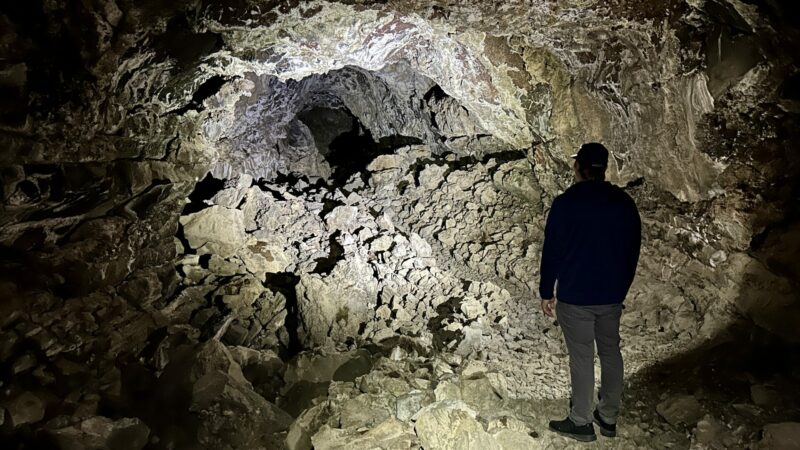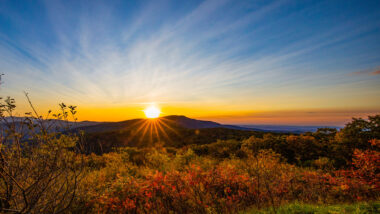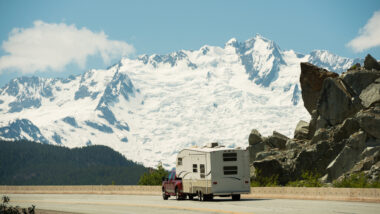Table of Contents Show
When you hear of a place with lava tubes, fumaroles, cinder cones, pit craters, lava flows, and volcanic fields, you might think we’re talking about a location in Hawaii. But today, we’ll explore the unique history and landscape of Lava Beds National Monument in northern California!
If you’ve never been here, you’ll want to add it to your trip itinerary. Adventurers will love the caving opportunities, and history buffs will relish the exhibits and sites detailing the Modoc War. Let’s dive in and learn more about Lava Beds National Monument!
Where Is Lava Beds National Monument?
Lava Beds National Monument sits in north-central California, northwest of Medicino National Forest, northeast of Klamath National Forest, and south of Tule Lake National Wildlife Refuge. The Main Park Road runs from Highway 120 in the north to Highway 130 in the south. Lava Beds National Monument is about 20-25 minutes south of the Oregon-California border.

What’s So Special About Lava Beds National Monument?
This national monument protects hundreds of caves, ancient rock art sites, historic battlefields, and a rugged landscape shaped by volcanic activity. This unique national monument has plenty to do above and below ground, from exploring the lava tube caves to hiking to visiting historic Modoc War sites.
Are There Hiking Trails At Lava Beds National Monument?
There are 13 hiking trails at Lava Beds National Monument. Pets aren’t permitted on any trail, however. Each trail meanders into the backcountry wilderness, so bring plenty of water, wear sunscreen and appropriate clothing, and check the weather before heading out.
Ten of the 13 trails are two miles or less. The Whitney Butte Trail is 3.3 miles, the Three Sisters Trail is 8.7 miles, and the Lyons Trail is 9.4 miles.
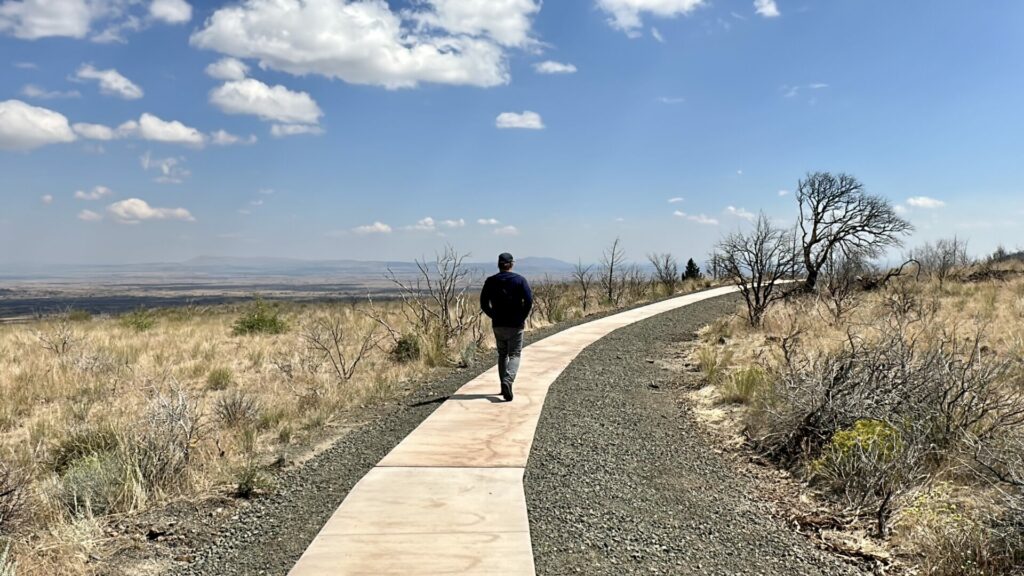
Things To Do At Lava Beds National Monument
There are also a few historic sites from the Modoc War worth exploring. And if you’re looking for a primitive campground, the Indian Well Campground is just half a mile from the visitor center.
Begin At the Visitor Center
You should always start at the visitor center of any national park site. You can grab a map, browse exhibits, and learn more about the site here.
At Lava Beds National Monument, the visitor center is open year-round from 9:30 a.m. to 5 p.m. If you plan on taking a cave tour, you must get screened for white-nose syndrome and acquire a Caving Permit. Both of these are free and can be done at the visitor center.
There are over 20 caves you can explore on your own, and we highly recommend doing so! The caves range from beginner to challenging, so you’re bound to find something to suit your needs.
Explore Mushpot Cave
The Mushpot Cave is an excellent introductory cave to get acquainted with the cave systems in Lava Beds National Monument. It’s well-lit and has a paved floor. You still have some stairs and may have to duck-walk as you navigate the 770 feet of Mushpot Cave. But it’s ideal for first-time visitors and visitors of almost all abilities.

Visit the Historic Sites Of the Modoc War
Gillem’s Camp was the temporary quarters of Army soldiers during the Modoc War. The Gillem Bluff Trail is a 0.7-mile one-way hike that climbs 550 in elevation to the top of Gillem Bluff, otherwise known as Sheepy Ridge. This is the route the soldiers would have carried supplies to the camp. You’ll also enjoy sweeping vistas of the surrounding landscape at the top of the bluff.
You can also walk the 0.5-mile inner or 1.5-mile outer trail of Captain Jack’s Stronghold. Wear sturdy shoes as the terrain is rugged. Along the way, you can read interpretive signs about the Modoc wartime defenses as they endured the winter of 1872-1873.
Explore Skull Cave
Skull Cave is listed as a beginner cave, and we would agree. This cave is unique because it has an ice floor and is colder than the others. There are also lots of steep stairs going down.
It’s a wide-open space, so it’s better for folks who dislike the other caves’ tight quarters. Pronghorn, bighorn sheep, and human bones have all been found here. You can still see the bighorn sheep skull at the bottom of the path. Skull Cave is about 2.4 miles from the visitor center and has a parking lot at the entrance.

Hike To the Schonchin Butte Fire Lookout
The Schonchin Butte Trail is a 1.4-mile out-and-back hike that climbs to a fire lookout tower at the top of a cinder cone. It’s a steep trail, rising 500 feet in less than a mile, but the breathtaking views from the tower are worth the effort.
There are also interpretive panels describing the surrounding landmarks. A firefighter is on duty during the summer months only, and kids can participate in the Junior Fire Lookout program.
Pro Tip: If you’re impressed by this national monument so far, you need to read all about The National Monuments That Are Better Than Most National Parks!
Explore Valentine Cave
Valentine Cave was our favorite! It has a different look than the others, with smoother walls and floor. You’ll have to crawl and duck-walk through 1,635 feet to explore the entire cave. T
he cave gets gradually thinner as you move along, so feel free to turn around whenever it feels too small for you. We didn’t complete the entire trail, and you don’t have to either! This cave is about 1.6 miles from the visitor center and has a parking lot at the entrance.

Stay Overnight At Indian Well Campground
The Indian Well Campground is mostly for tent campers and small RVs. Only some campsites can accommodate RVs up to 30 feet long. Although we did see one 40′ fifth wheel squeak into a spot, we don’t recommend trying this. His rear end was hanging into the road.
The 42 first-come, first-served sites have a fire ring, picnic table, and cooking grill. The cost is $10 per night, with no hookups, dump stations, or showers. So be prepared to dry camp! However, there are restrooms year-round.
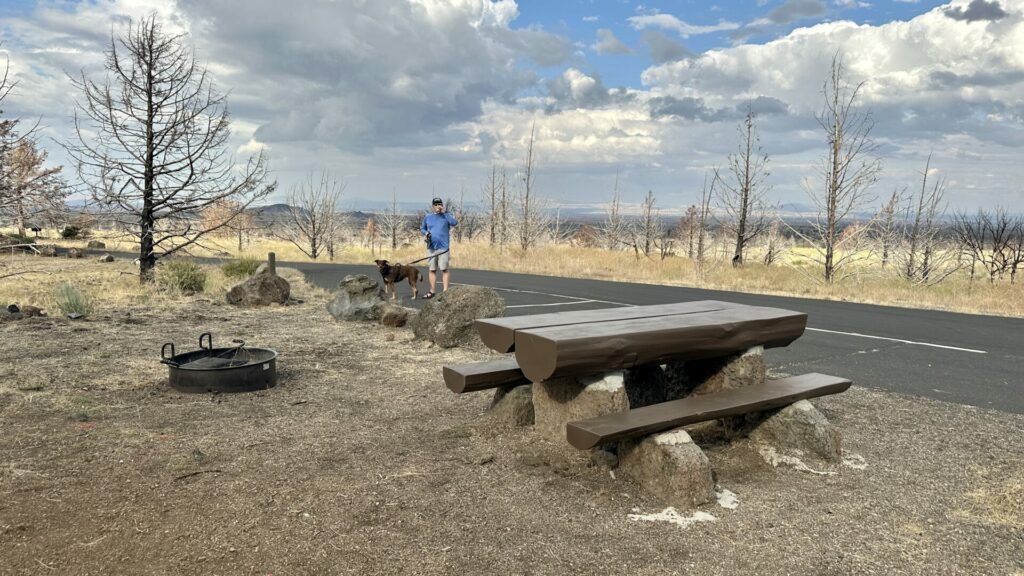
Learn More: Looking for more epic places? Be sure to read about the 10 Southwestern National Monuments You Need to Visit at Least Once!
How To Stay Safe While Visiting Lava Beds National Monument
There are some risks because of the caving opportunities at Lava Beds National Monument. Wear long pants, long sleeves, and closed-toed shoes to stay safe. Even if it’s 90 degrees outside, the caves remain around 55 degrees year-round.
You should also bring your own flashlight. Helmets are sold in the visitor center, or you can bring your own. A bicycle helmet will work. If you plan on exploring Valentine Cave, you may want to bring gloves and knee pads as you’ll be crawling on jagged lava.
We weren’t prepared at all when visiting, but we managed to still have a great time with just flashlights and close toed shoes. However, if you plan on doing some serious caving, we recommend getting all the proper equipment.
When visiting in the summer, bring plenty of water, sunscreen, and a wide-brimmed hat. The hikes cross into backcountry wilderness, and there is very little shade. When hiking, keep your eyes open for mountain lions. Although they avoid people, this is their territory. To scare off a mountain lion, throw rocks, shout, and make yourself appear as big and mean as possible.
Also, never put your hand under rocks, and pay attention to where you step. Rattlesnakes also inhabit this region. If you hear a rattle, heed its warning and back away.
Finally, some wild animals in Lava Beds National Monument transmit diseases. Beware of rodents and fleas. Although plague is rare, it can be transmitted via a flea bite. Pet owners can then get this disease from their pets if not properly treated. You also want to keep your head turned away from rodent droppings while caving.
How Much Does It Cost To Visit Lava Beds National Monument?
Lava Beds National Monument is open year-round. All visitors require an entrance pass. A vehicle pass is $25 and is good for up to seven days for everyone in the car. You can purchase this pass at the visitor center. If you plan on visiting Lava Beds National Monument several times a year, consider the annual pass. It’s $55 and valid for up to a year from the purchase date.
Interagency passes will get you into Lava Beds National Monument for free. Passes are for military, seniors, 4th graders, persons with disabilities, and volunteers. Suppose you don’t fit into one of those categories. In that case, you can purchase the America the Beautiful pass for $80, which gets you in any site managed by the National Park Service, U.S. Fish & Wildlife Service, U.S. Forest Service, Bureau of Land Management, Bureau of Reclamation, or U.S. Army Corps of Engineers for free.
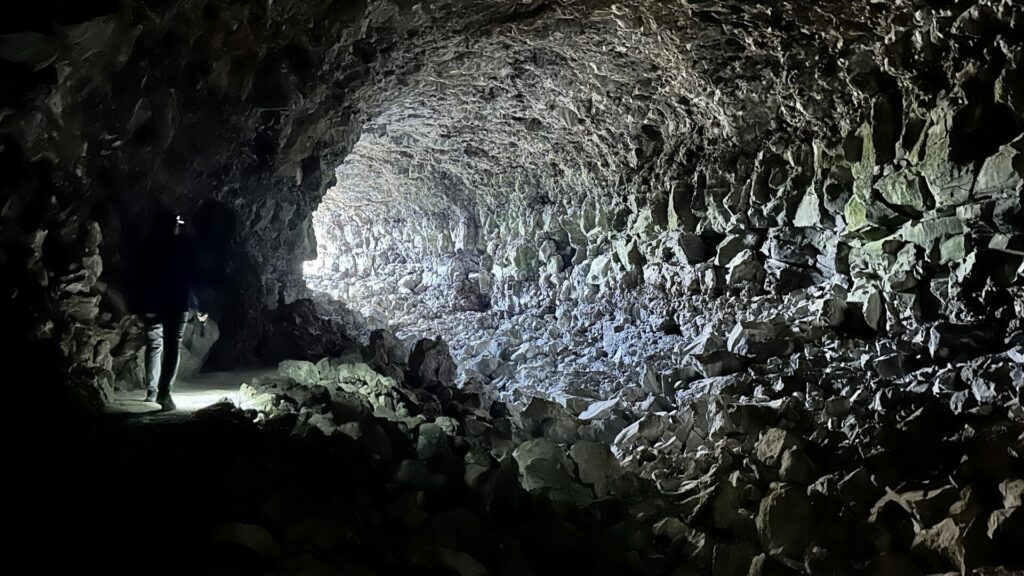
Explore This: Here are 10 National Monuments Everyone Needs to Visit at Least Once!
Is Visiting Lava Beds National Monument Worth It?
You don’t need more than a day to explore Lava Beds National Monument. But it’s a site worth putting on your northern California itinerary. Another national park site, Tule Lake National Monument, is less than ten miles northeast. It’s home to the largest camp where Japanese Americans were incarcerated during World War II. You could easily visit both in a single day.
In 1925, the federal government protected Lava Beds National Monument. Its unique 46,000-acre landscape – from dozens of lava tubes to high desert shrubbery to cinder cones – might appear like you’ve landed on another planet. And the story of the Modoc War between the Modoc Native Americans and the U.S. Army is preserved here.
So the next time you travel through northern California, consider detouring for a day at Lava Beds National Monument. What will you learn on your visit?




